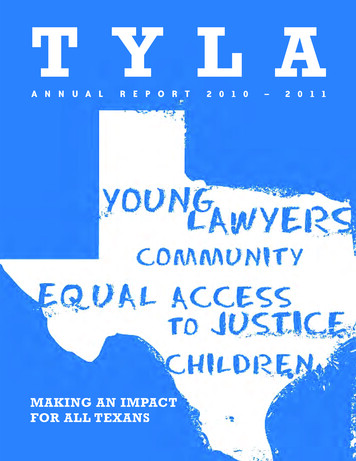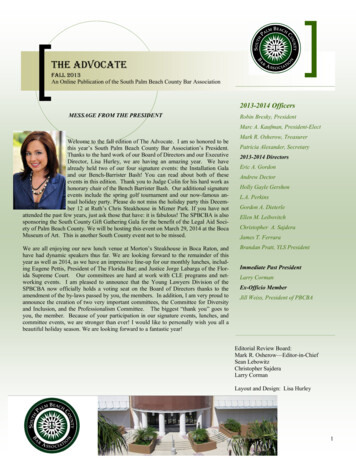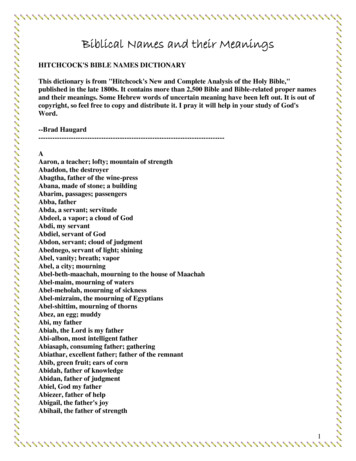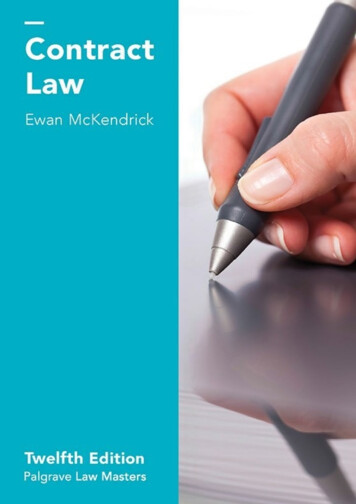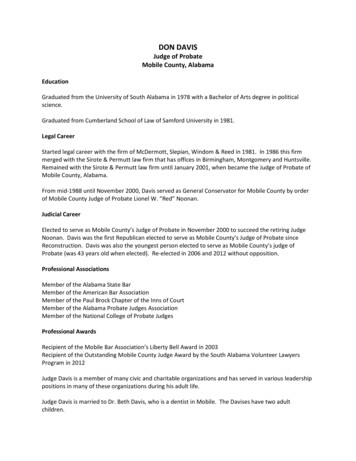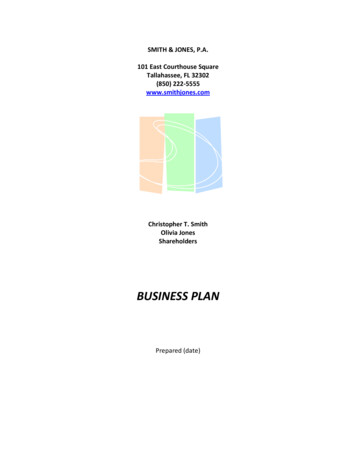
Transcription
HITCHCOCK LAW FIRMPLLC5614 CONNECTICUT AVENUE, N.W. NO. 304WASHINGTON, D.C. 20015-2604(202) 489-4813 FAX: (202) 315-3552CORNISH F. HITCHCOCKE-MAIL: CONH@HITCHLAW.COM15 January 2021Office of the Chief CounselDivision of Corporation FinanceSecurities & Exchange Commission100 F Street, N.E.Washington, D.C. 20549By electronic mail: shareholderproposals@sec.govRe:Shareholder proposal to Citigroup Inc. fromCtW Investment GroupDear Counsel:I write on behalf of CtW Investment Group ("CtW'') in response to a letter("Citigroup Letter") from counsel for Citigroup Inc. ("Citigroup" or the "Company")dated 23 December 2020. In that letter Citigroup states its intent to omit CtW'sshareholder proposal (the "Proposal") from Citigroup's 2021 proxy materials. Forthe reasons set forth below, we respectfully ask the Division to advise Citigroupthat the Division does not concur with the Company's position that the Proposalmay be excluded from the Company's proxy materials.The ProposalThe Proposal asks Citigroup to conduct a "racial equity audit." The text ofthe resolution reads:RESOLVED: that shareholders of Citigroup Inc. ("Citi") urge theBoard of Directors to oversee a racial equity audit analyzing Citi'sadverse impacts on nonwhite stakeholders and communities of color.Input from civil rights organizations, employees, and customers shouldbe considered in determining the specific matters to be analyzed. Areport on the audit, prepared at reasonable cost and omittingconfidential or proprietary information, should be publiclydisclosed on Citi's website.
2The Supporting Statement notes that the high ·profile police killings of blackpeople have galvanized the movement for racial justice, a topic that, along with theCOVID-19 virus, have focused public attention on systemic racism, racializedviolence and inequities in employment, health care, and the criminal justice system.The Supporting Statement acknowledges that in September 2020, Citigroupannounced its commitment to "leading the way and investing in communities ofcolor to build wealth and strong financial futures." To that end, Citigroupcommitted 1 billion over four years to close the racial wealth cap.Notwithstanding such statements, the Supporting Statement continues, Citigrouphas a "conflicted history" with respect to racial injustice in the communities itserves, citing: a 2019 fine of 25 million by the Office of the Comptroller of the Currencyfor failing to offer all eligible customers mortgage discounts and credits, a practicethat adversely affects customers of color; the imposition of a 12/month fee for checking accounts or a minimum dailybalance of 1,500- a practice that disproportionately affects people of color and caninhibit wealth creation in their communities; a February 2020 Stanford study showing that there is only one blackexecutive, even though 45.8% of the workforce consists of people of color; Citigroup's practice with respect to the Paycheck Protection Program ofaccepting funding applications only from clients with an existing bankingrelationship, notwithstanding the Company's acknowledgme t in its September2020 statement that the Company's "policy of not taking non-customers mightcreate heightened risk of disparate impact on minority and women ·ownedbusinesses"; Citigroup's donations of 242,000 during the 2020 election cycle to 74members of Congress who were rated "F'' by the NAACP.In response, Citigroup argues that the Proposal may be omitted from itsproxy materials under SEC Rule 14a·S(i)(l0), which authorizes the omission of aproposal if "the company has already substantially implemented the proposal." Aswe now explain, Citigroup's efforts fall far short of meeting that standard.Discussion.Citigroup argues that the Company has achieved the "key goals" of theProposal, citing a series of announcements of initiatives and programs in which theCompany is seeking to "identify, prioritize and remedy'' racial injustice.Specifically, Citigroup cites a 2019 ESG report in which the Company'scommitments in the area of addressing racial inequality, as well as a September2020 report and some mostly contemporaneous press releases that the Companyissued in response to the killings of George Floyd, Breonna Taylor and other
3African·Americans. 1 These measures are, the Company acknowledges, "just thefirst step in a long journey"; nonetheless, the Company continues, these measureshave achieved the "essential objective" of the Proposal, and the Proposal mayproperly be excluded from Citigroup's proxy materials.Unfortunately, this argument misses the point of the Proposal.The Proposal is not asking the Company to lay out a program that explainswhat Citigroup plans to do in the future. Instead the Proposal requests anindependent audit of existing operations and plans. Such an audit may addressissues that Citigroup is not addressing or addressing inadequately, as well as anassessment of the likely effectiveness of the measures the Company has agreed toundertake.A good explanation of the value of an audit is provided on the Commission'sweb page, All About Auditors: What Investors Need to Know, available ations/investorpubsaboutauditorshtm.html. The publication states:What's the Purpose of an Audit?An audit provides the public with additional assurance - beyondmanagements' own assertions - that a company's financialstatements can be relied upon. As the U.S. Supreme Court stated inthe landmark case of U.S. v. Arthur Young: "The SEC requires thefiling of audited financial statements in order to obviate the fear of lossfrom reliance on inaccurate information, thereby encouraging public1Citigroup Inc., 2O19Environmental, Social and GovernanceReport(2019),available athttps://www -ESG-Report·2019.pdf?ieNocache 135;Citigroup Inc., Closing the Racial Inequality Gaps: The Economic Cost ofBlackInequality in the U.S. (Sept. 2020),available at https://www equality-gapsCitigroup, Inc., Action for Racial Equality, available athttps://www .citigroup.com/citi/racial·eguity; andCitigroup, Inc., Citi Launches More Than 1 Billion in Strategic Initiatives to HelpClose the Racial Wealth Gap (23 September 2020), available .htmCitigroup's lengthy recitation of the Company's recent actions, as described in thesedocuments, might be read to suggest that CtW perhaps unaware of these facts when it filedthe Proposal. CtW was fully aware of these documents, as is indicated by note 1 of theProposal, which cites the most recent of those documents.
4investment in the Nation's industries." That has importantimplications for investors making investment decisions, for banks andfinancial institutions that may extend credit or make loans to thecompany, and for other businesses and members of the public who dealwith the company.The key thought is in the first sentence: An audit is important as a way toprovide an "additional assurance - beyond managements' own assertions" aboutwhat the Company is doing.To be sure, the context of the quoted language is slightly different, but thebasic point is the same. Citigroup's "management" has unrolled a series ofprograms, statements and commitments that aim to persuade investors and thepublic that the Company "gets it" and is willing to make significant commitmentsgoing forward.But are those the right measures? Will they work? What else may need to bedone? Those are the sorts of questions that an audit can raise and answer.That is where the Proposal's request comes in, and there is ample precedentfor companies conducting such an audit not simply of the company's employmentpractices, but the company's business operations. Consider these three examples ofthe type of audit that the Proposal is requesting and that will allow investors (andthe public generally) to understand the adequacy of"management assertions" that acompany has responded to a particular situation. Consider first the experience at Facebook, as summarized in Facebook'sCivil Rights Audit- Final Report (8 July 2020), available /Civil· Rights· Audit· Final·Report.pdf. This 89-page report, undertaken by professionals with civil rightsexpertise, was released after a two-year examination and several interim reports,was "intended to help the company identify, prioritize, and implement sustainedand comprehensive improvements to the way it impacts civil rights." Id. at p. 3. Tothat end, the audit examined not simply Facebook's employment practices, but allphases of that company's business, including Facebook's customer-facing activities. 2The audit described in detail how Facebook was able to use the audit process "tolisten, plan and deliver on various consequential changes that will help advance the2The Facebook report notes that the audit began with a focus on specific topics,including "voter suppression and voter information, building a civil rights accountabilityinfrastructure, content moderation and enforcement (including hate speech andharassment), advertising targeting and practices, diversity and inclusion, fairness inalgorithms and the civil rights implications of privacy practices," and expanded to cover afull range of civil rights issues. Id at p. 5.
5civil rights of its users" in at least12 categories (summarized at pp.6·8), whileidentifying several areas where the audit believed more work was needed(summarized at p. 8). Consider next an audit conducted several years ago at Airbnb, which led toa 2016 report entitled Airbnb's Work to Fight Discrimination and Build Inclusion: AReport Submitted to Airbnb, available at 9/REPORT Airbnbs· Work·to· Fight· Discrimination ·andBuild-Inclusion.pdf. The report focuses on ways to address the potential for biasand discrimination in Airbnb's basic business model (summarized at p. 2), which isthat:Hosts create profiles for themselves and their property, choose theirown price and availability, and set guidelines for guests. Hosts andguests learn about each other through past reviews and personalcommunication through the Airbnb platform. Guests and hosts useAirbnb to confirm travel dates and expectations, and make and receivepayments. After the stay, both hosts and guests leave reviews for oneanother, which are public for all future hosts and guests to read.The 32-page report discusses various "lessons learned" and recommends a series ofactions that can be taken, which the company agreed to take. Finally, consider the civil rights audit at Starbucks. This audit, led byformer U.S. Attorney General Eric Holder, was precipitated by the April 2018 arrestof two African-American men, who were seated in a Philadelphia Starbucks waitingfor a business meeting to begin. The Holder investigation produced a 67-pagereport, A Report to Starbucks: An Examination ofStarbucks' Commitment to CivilRights, Equity, Diversity, and Inclusion (Jan. 2019), available vington·Report·to·Starbucks·Jan·23-2019.pdf, as well as a followup assessment, A Report to Starbucks on theProgress ofits Efforts to Promote Civil Rights, Equity, Diversity, and Inclusion(Feb. 2020), available at bucks·Civil· Rights·Assessment-2020· Update.pdfThe audit was commissioned "to review and evaluate Starbucks'multifaceted approach to creating an inclusive and equitable work environment forpartners and a welcoming third place for customers" (2019 Report at p. 11). As Mr.Holder noted (id. at p. 5), the two arrests "may not have been the result of explicitracial animus, the arrests demonstrated powerfully that unaddressed implicit biascan sometimes produce outcomes that are difficult to distinguish from thosemotivated by conscious racism."The Holder report is significant because the Philadelphia incident alerted
6Starbucks' management to the need for an immediate response in order to reassurecustomers, investors and the public generally. That initial response included theclosing all 8,000 North American stores for a day in order to train 175,000employees on implicit bias; in addition Starbucks undertook a review of companypolicies for addressing situations such as the one in Philadelphia (id. at p. 20).Although that training was "unprecedented in scale" for Starbucks," (id. at p.21), the company realized the importance of looking beyond the specific incident andthe company policies implicated by that incident. To that end, Starbucks'management commissioned the audit led by Mr. Holder, which examined thecompany's policies more broadly and led to recommendations for additional change.So too here, the events during the summer of 2020 prompted Citigroup torecognize that actions must be taken immediately to address racial justice concerns- hence the measures cited in Citigroup's press releases and reports, culminating inthe program outlined in September 2020.But are those steps enough? Is there more that can and should be done?Those questions cannot be answered by self-congratulatory press releases andreports. Instead, the questions can be answered only by the sort of in·depthassessment that CtW Investment Group is requesting in its proposal.And indeed, if Citigroup's letter describes the Company's actions as "just thefirst step in a long journey," can it really be said that Citigroup has "substantiallyimplemented" the Proposal?ConclusionFor these reasons, we respectfully ask the Division to advise Citigroup thatthe Division does not concur that CtW's Proposal may be omitted under Rule 14a·8(i)(l0).Thank you for your consideration of these points. Please feel free to contactme if any additional information would be helpful.Very truly yours,Cornish F. Hitchcockcc: Shelley J. Dropkin
Shelley J. DropkinManaging DirectorDeputy Corporate Secretaryand General Counsel,Corporate GovernanceCitigroup Inc.388 Greenwich Street17th FloorNew York, NY 10013T 212 793 7396dropkins@citi.comDecember 23, 2020BY E-MAIL [shareholderproposals@sec.gov]U.S. Securities and Exchange CommissionOffice of Chief CounselDivision of Corporation Finance100 F Street, NEWashington, D.C. 20549Re: Stockholder Proposal to Citigroup Inc. from CtW Investments GroupLadies and Gentlemen:Citigroup Inc. (the “Company”), in accordance with Rule 14a-8(j) under the SecuritiesExchange Act of 1934, as amended (the “Exchange Act”), is filing this letter with respect to thestockholder proposal and supporting statement (the “Proposal”) submitted by CtW InvestmentGroup (the “Proponent”) in a letter dated November 6, 2020. The Proponent seeks inclusion ofthe Proposal in the proxy materials that the Company intends to distribute in connection with its2021 annual meeting of stockholders (the “2021 Proxy Materials”). A copy of the Proposal andall correspondence with the Proponent related to the initial submission of the Proposal are attachedhereto as Exhibit A.In accordance with Staff Legal Bulletin No. 14D (Nov. 7, 2008) (“SLB No. 14D”), thisletter and its attachments are being submitted to the staff of the Division of Corporation Finance(the ‘Staff”) of the Securities and Exchange Commission (the “Commission”) by e-mail toshareholderproposals@sec.gov. Pursuant to Rule 14a-8(j), this letter is being filed with theCommission no later than 80 days before the Company intends to file its 2021 Proxy Materials.The Company intends to commence printing its Notice and Access materials on or about March 7,2021 and to file its 2021 Proxy Materials on or about March 17, 2021. A copy of this letter andits attachments also is being sent on this date to the Proponent in accordance with Rule 14a-8(j) toinform the Proponent of the Company’s intention to omit the Proposal from the 2021 ProxyMaterials. For purposes of the following analysis, references to the Company shall include theCompany’s direct and indirect subsidiaries.Rule 14a-8(k) and SLB No. 14D provide that the Proponent is required to send theCompany a copy of any correspondence the Proponent elects to submit to the Commission or theStaff. Accordingly, we are hereby informing the Proponent that if the Proponent elects to submit
additional correspondence to the Commission or the Staff with respect to this Proposal, a copy ofthat correspondence should be furnished concurrently to the Company.The Company hereby requests confirmation that the Staff will not recommend enforcementaction if, in reliance on Rule 14a-8 of the Exchange Act, the Company omits the Proposal from its2021 Proxy MaterialsShould the Staff disagree with the conclusions set forth in this letter, or should anyadditional information be desired in support of the Company’s position, we would appreciate theopportunity to confer with the Staff concerning these matters prior to the issuance of the Staff’sresponse. Please do not hesitate to contact the undersigned at (212) 793-7396. andrate Governancecc:CtW Investment Group1900 L Street, N.W., Suite 900Washington, DC 20036Attention: Dieter Waizenegger, Executive Director
THE PROPOSALThe Proposal provides as follows:RESOLVED that shareholders of Citigroup Inc. (“Citi”) urge the Board ofDirectors to oversee a racial equity audit analyzing Citi’s adverse impacts onnonwhite stakeholders and communities of color. Input from civil rightsorganizations, employees, and customers should be considered in determiningthe specific matters to be analyzed. A report on the audit, prepared at reasonablecost and omitting confidential or proprietary information, should be publiclydisclosed on Citi’s website.A copy of the Proposal and correspondence related to the initial submission ofthe Proposal is attached hereto as Exhibit A.BASIS FOR EXCLUSIONThe Company believes that the Proposal may be properly excluded from the 2021 ProxyMaterials in reliance on Rule 14a-8(i)(10) because the Company has substantially implementedthe essential elements of the Proposal.ANALYSISI.The Proposal May be Excluded Pursuant to Rule 14a-8(i)(10) Because the Companyhas Substantially Implemented the Essential Elements of the Proposal.A. Rule 14a-8(i)(10) BackgroundUnder 14a-8(i)(10), a stockholder proposal may be excluded from a company’s proxymaterials when the company has already substantially implemented the proposal. The Staff hasstated that “substantial” implementation under the rule does not require implementation in full orexactly as presented by the proponent. See Exchange Act Release No. 34-40018 (May 21, 1998,n.30). The Staff has provided no-action relief under Rule 14a-8(i)(10) when a company hassubstantially implemented and therefore satisfied the “essential objective” of a proposal, even ifthe company did not take the exact action requested by the proponent, did not implement theproposal in every detail or exercised discretion in determining how to implement the proposal. SeeWalgreens Boots Alliance, Inc. (November 13, 2018) (permitting exclusion of a shareholderproposal requesting that the company issue a report describing how the company’s policies andpractices advance the UN Sustainable Development Goals where the requested information wasalready available in the company’s corporate social responsibility report); Exxon MobilCorporation (March 23, 2018) (permitting exclusion of a shareholder proposal requesting that thecompany issue a report describing how the company could adapt its business model to align witha decarbonizing economy where the requested information was already available in two publishedreports describing the company’s long term outlook for energy and how it would position itself fora lower-carbon energy future); Ford Motor Company (February 22, 2016) (permitting exclusionof a shareholder proposal requesting that the company adopt a policy disclosing the gender,race/ethnicity, skills and experiences of each board nominee where the requested information wasalready available in a chart disclosing the aggregate gender and minority status of the company'sdirectors in its sustainability report and the specific qualifications required of board nominees as
well as each director's actual skills and experiences as it relates to those qualifications in its proxymaterials); and Wal-Mart Stores, Inc. (March 25, 2015) (permitting exclusion of a shareholderproposal requesting an employee engagement metric for executive compensation where a“diversity and inclusion metric related to employee engagement” was already included in thecompany's management incentive plan).B. The Company Has Already Addressed the Proponent’s Essential Objective andUnderlying ConcernsThe core of the Proposal, or its “essential objective,” is for the Board of Directors of theCompany to oversee the preparation of a racial equity audit to help the Company “identify,prioritize, remedy and avoid adverse impacts on nonwhite stakeholders and communities of color.”The Company has prepared and made public on its website a number of reports and analysesrelated to racial equity and the efforts the Company is taking. These reports and analyses includethe Company’s: 2019 Environmental, Social and Governance Report (“2019 ESG Report”).12020 report on Closing the Racial Inequality Gaps (the “Racial InequalityReport”).2Press releases posted to the “Action for Racial Equity” page of the Company’swebsite that outline initiatives it has taken.3Furthermore, on September 23, 2020, the Company issued a press announcing its Action for RacialEquity Initiative,4 in which the Company committed over 1 billion in strategic initiatives to helpclose the racial wealth gap and increase economic mobility in the United States. In connectionwith the announcement of the Action for Racial Equity Initiative in September 2020, theCompany’s CEO stated the following:“Addressing racism and closing the racial wealth gap is the most criticalchallenge we face in creating a fair and inclusive society and we knowthat more of the same won’t do. . . We are bringing together all thecapabilities of our institution—our people, our lines of business, ourbalance sheet, and our philanthropy—like never before to combat theimpact of racism in our economy. This is a moment to stand up and beCitigroup Inc., 2019 Environmental, Social and Governance Report (2019), available d/2019/Global-ESG-Report-2019.pdf?ieNocache 135.1Citigroup Inc., Closing the Racial Inequality Gaps: The Economic Cost of Black Inequality in the U.S. (Sept. 2020),available at acial-inequality-gaps.2These press releases can be found on the Company’s dedicated webpage to “Action for Racial uity) (the “Action for Racial Equity Webpage”).3See Press Release, Citi Launches More Than 1 Billion in Strategic Initiatives to Help Close the Racial WealthGap (Sept. 23, 2020), available at tm.4
counted, and Citi is committed to leading the way and investing incommunities of color to build wealth and strong financial futures.”5The following is a summary of the Company’s 2019 ESG Report, Racial Inequality Reportand Action for Racial Equity Initiative, which either alone or in combination with numerous othersteps the Company has taken to address racial inequity show how the Company has reported onits efforts to ‘identify, prioritize and remedy” racial inequality, as requested by the Proposal.1. 2019 ESG ReportThe 2019 ESG Report, which was reviewed and supported by the Board of Directors of theCompany, describes how the Company has committed to “identify” the racial inequality in itsindustry, which is one of the essential objectives of the Proposal. The 2019 ESG Report analyzes,through a detailed and statistic-based approach, the disparities that impact minority-owned smallbusinesses. The Company also describes the efforts it has taken to “remedy” these disparities. Forexample, the 2019 ESG Report states that “the gender and race gaps in the world of smallbusinesses are very real, with reports showing that less than 3 percent of venture capital fundingis allocated to women- and minority-owned startups,” and that the Company “aims to change thestatistics for women- and minority-owned businesses by investing in programs that emphasizeentrepreneurship, employee ownership and local contracting.” The Company’s 2019 ESG Reportprovides specific details of the Company’s various efforts to “build more inclusive, resilient andsustainable communities,” 6 which shows how it has “identified,” “prioritized” and taken steps to“remedy” the impacts of racial inequality in its industry. The 2019 ESG Report describes thefollowing initiatives: Providing 6 billion in loans for affordable housing projecting in the United States. 7 Launching a 150 million venture capital fund to allow the Company to make investmentsin U.S. companies that are addressing societal challenges—prioritizing companies that areled or owned by women or minorities and that are using technology and innovation to helpaddress four key societal challenges. 8 In 2019, raising the minimum wage of the Company’s U.S.-based employees to 15 anhour.See Press Release, Citi Launches More Than 1 Billion in Strategic Initiatives to Help Close the Racial Wealth Gap(Sept. 23, 2020), available at tm. In that press release, KristenClarke, President & Executive Director of the Lawyers’ Committee for Civil Rights Under Law, was quoted as statingthat “Citi is going beyond talking about discrimination by implementing concrete strategies to address longstandinginequities in communities of color Citi is charting a course that we hope will be replicated throughout the sector.”562019 ESG Report, p. 23.72019 ESG Report, pp. 23 & 30.82019 ESG Report, pp. 17 & 33.
Continuing its study of pay equity across the Company to identify gaps in pay betweenmen and women globally and minorities and non-minorities in the United States. 92. Racial Inequality ReportThe Company’s Racial Inequality Report is another important example of how theCompany has taken meaningful steps to address the essential objectives of the Proposal. TheProposal seeks that the Company “identify” racial inequality in its industry and “prioritize” theefforts that are needed. Through more than 80 pages of detailed analyses and statistics relating toracial and economic gaps, the Racial Inequality Report attempts to identify the underlying causesof the racial and economic gaps exacerbated by the COVID-19 pandemic, discusses the value ofclosing racial inequity gaps and outlines how governments, corporations, and individuals can worktogether to eliminate such gaps.3. Action for Racial Equity InitiativeThe Company’s Action for Racial Equity Initiative outlines key goals for its racial equityinitiatives, discusses why each goal is important and describes the action items the Company willchampion to reach each goal, which clearly show how the Company is trying to “identify,prioritize, remedy and avoid adverse impacts on nonwhite stakeholders and communities ofcolor.” The Proposal references the Company’s Action for Racial Equity Initiative but ignoresthe fact that the initiative demonstrates how the Company has thoughtfully analyzed theimportant issues of racial equity, considered the various reports and initiatives it has preparedover the years and presented clear and measurable actions to take steps to address the systemicinequities in its business and industry.In the table below we outline (a) the four key goals of the Action for Racial EquityInitiative; (b) why each goal is important; and (c) the key action items that the Company hascommitted to with respect to each goal. 10GoalExpand Bankingand Access toCredit inCommunities ofColor9Why ImportantMany communities of color lackaccess to traditional banking servicesthat are the foundation of financialstability and thriving communities.Economic security is also hamperedby insufficient access to credit,which makes it hard to qualify foraffordable mortgages and smallbusiness loans.Key Action Items Provide Minority DepositoryInstitutions (MDIs) with up to 50million in growth capital tostrengthen their ability to serveracially diverse households andentrepreneurs. Generate revenue for MDIs byinviting them into up to 50 millionin loan participationopportunities between the Citi2019 ESG Report, pp 64-65.See Press Release, Citi Launches More Than 1 Billion in Strategic Initiatives to Help Close the Racial WealthGap (Sept. 23, 2020), available at tm. See also Citigroup:Action for Racial Equity, available at https://www.citigroup.com/citi/racial-equity.10
GoalWhy ImportantKey Action ItemsCommunity Capital division in theInstitutional Clients Group and itsclients to finance affordable multifamily rental housing. Provide pro-bono technicalassistance and training to MDIs—through a collaboration with Deloitteand others—to help MDIs navigatethe changing economy, improveoperational efficiencies and supporttalent development. Partner with communityorganizations serving racially diversehouseholds through the Company’sU.S. Consumer Bank to expandaccess to the Citi Access AccountPackage, which includes low-costchecking and savings products andnew digital financial education. Alleviate one of the biggest barriersto banking by expanding the CitiATM Community Network programthat removes out-of-network fees atCitibank ATMs for customers ofparticipating minority-owned banksand community development creditunions. Since 2016, Citi’s U.S.Consumer Bank has removed thesefees for 440,000 customers of 28institutions. Put 1 million youth on the path tohigher education by expanding theCiti Start Saving platform—whichinitially was developed to power
Starbucks' management to the need for an immediate response in order to reassure customers, investors and the public generally. That initial response included the closing all 8,000 North American stores for a day in order to train 175,000 employees on implicit bias; in addition
